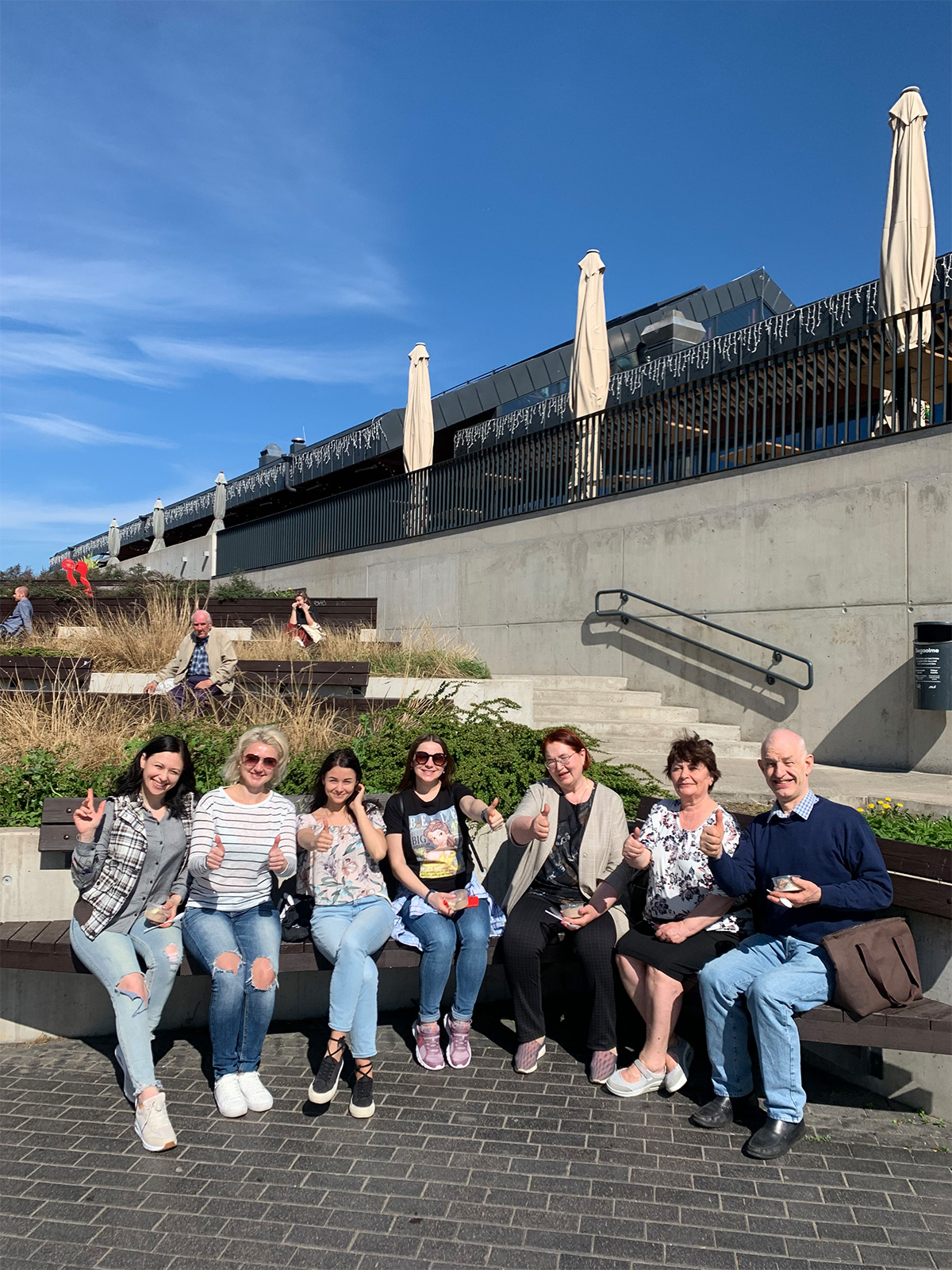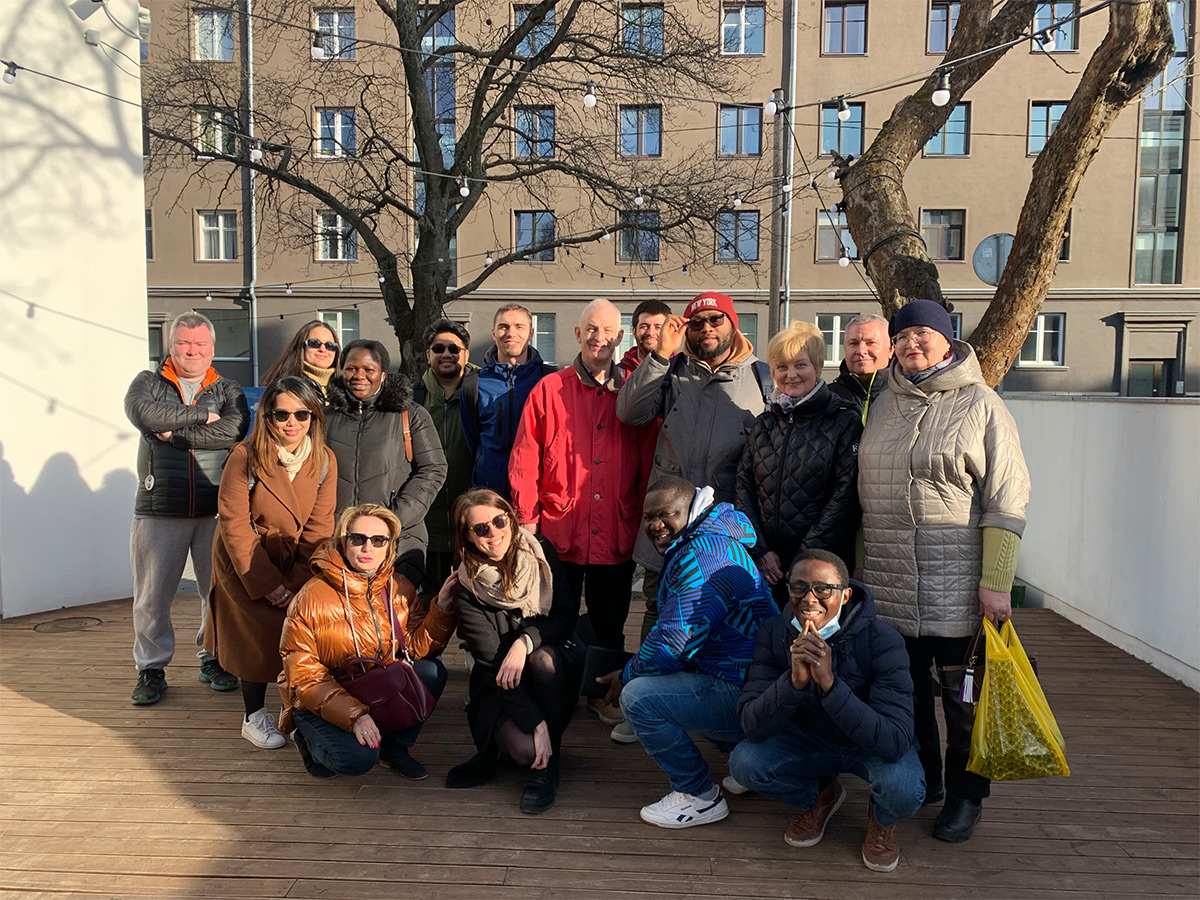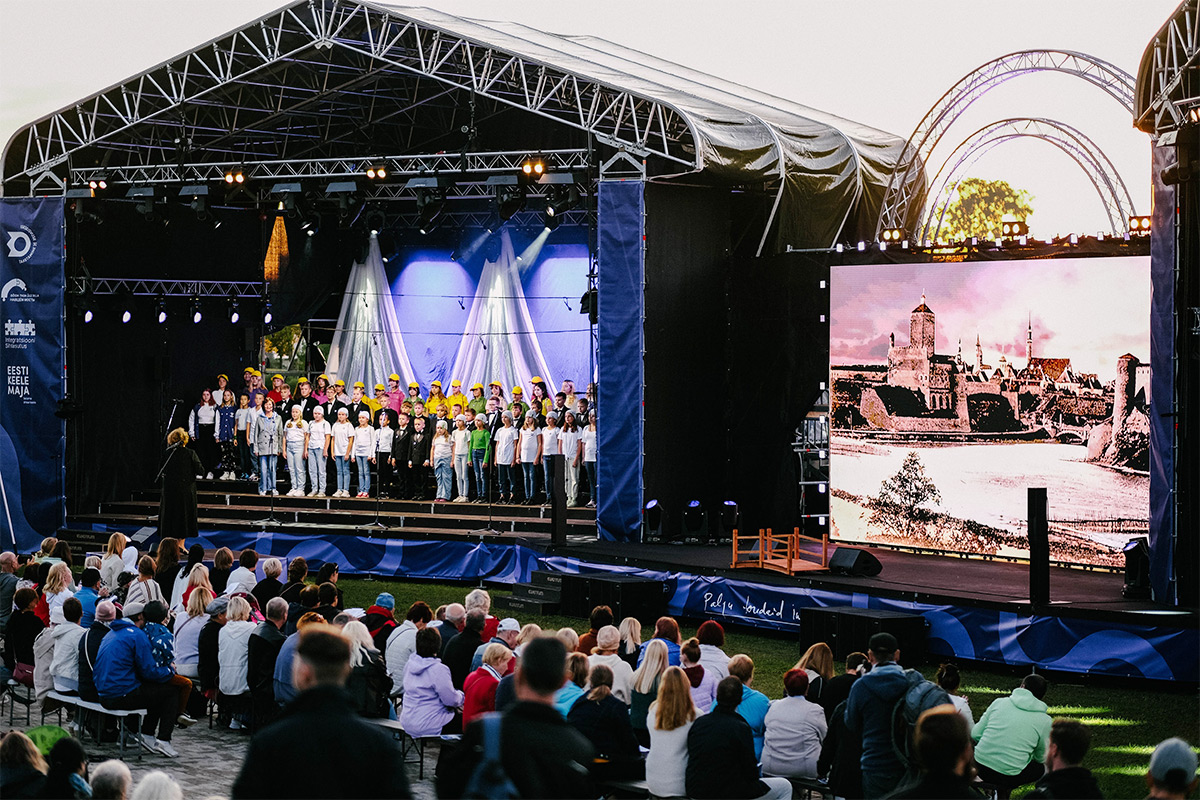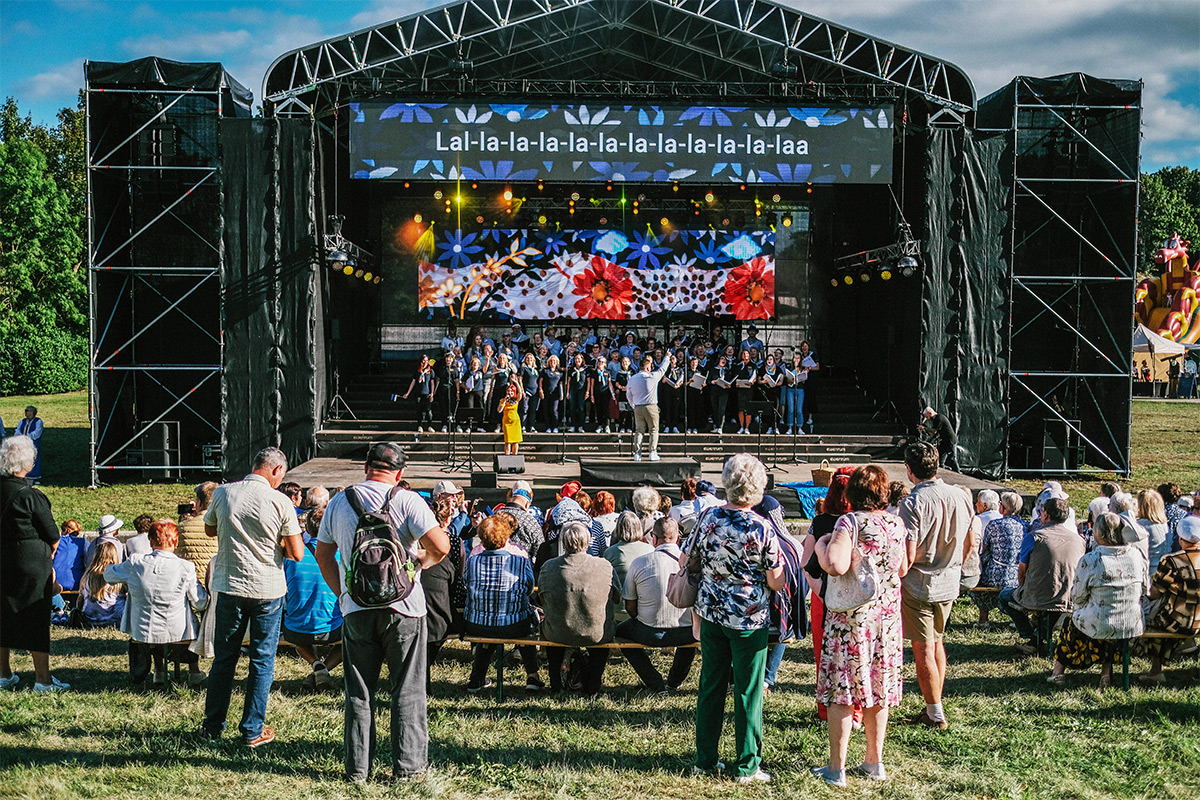This year, we celebrate the fifth anniversary of our Estonian Language Houses. During that time, the language houses have become a place for language learning and practice, but their role in the field of integration as a whole has also become increasingly important.
‘A new language and cultural centre, the Estonian Language House, opened in Tallinn on Wednesday. The aim of the centre is to help non-native speakers of Estonian to develop their language skills as well as to get a better intro into Estonian culture, with a view to participating in it more fully,' ERR wrote in January 2019, when the Estonian Language House in Tallinn officially opened its doors. In the autumn of the same year, a language house and the office of the Integration Foundation (INSA) were opened in Narva, in addition to Tallinn.
Above, we talked about the completion of the physical premises, but the Estonian Language Houses officially started operating already in 2018. ‘Establishing the houses was a political plan on the one hand, but a very practical one on the other. Two years before they opened, in November 2016, it was agreed at the government level that Estonian Language Houses would be established in Narva and Tallinn. The houses would organise Estonian language courses free of charge, develop teaching and methodological materials, and, through their activities, ensure compliance with the language requirements set by the state and the availability of high-quality Estonian language learning,’ recalls Eda Silberg, Undersecretary for Cultural Diversity at the Ministry of Culture, who worked at the Integration Foundation at the time and was responsible for launching the Estonian Language Houses.
This is how the idea was born to open Estonian Language Houses in Tallinn and Narva that would offer opportunities to practise the Estonian language, but also serve as integration centres in areas where the need is greatest. ‘The creation of the language houses was significant and a big challenge for the foundation, especially as the headquarters of the foundation moved to Narva at the same time and we had to find bright-eyed Estonian-speaking and -minded people for several positions at the same time,’ Silberg adds.
Today, studies confirm the effectiveness of the work of Estonian Language Houses. Feedback from those who have participated in the activities and services of the Estonian Language Houses indicates a high level of satisfaction with the language houses – in particular, the learners appreciated the opportunity of free modern language learning and other activities supporting language learning. The impact analysis of the Estonian Language Houses carried out in 2021 confirms that for the most part, participants in the services have said that their language skills improved significantly as a result of participating in the activities and more than 95% of respondents would recommend participating in the activities and services of the Integration Foundation to their acquaintances.
It is important to understand why language skills are necessary
The Estonian Language Houses have largely gained public attention thanks to projects promoting integration. Innovative and creative language learning is one aspect in which the Estonian Language Houses excel, but in fact, their important role is to be a centre of excellence in the field of integration more generally and so, they are involved in projects promoting integration in addition to traditional language learning. For example, several activities, such as the film academy, a rap opera, Moepööre (Fashion Revolution), and the Singing Picnic, have taken place in Narva, impacting Ida-Viru County and beyond. ‘When it comes to integration, it is very important to have a friend who speaks Estonian and has common interests with you. I dare to say that these projects have broken many barriers between communities,’ says Anna Farafonova, Head of the Estonian Language House in Narva, adding that this is not general feedback – she knows of real cases where someone in Ida-Viru County has gained the courage to start their own business or enter university after participating in a special language project. ‘If it is understood that learning a language is not an end in itself, but rather a means to open up new opportunities, the motivation of learners will increase significantly,’ says Farafonova.
Integration is not just about learning a language, but also about contacts and communication between different people, says Dmitri Moskovtsev, Director of the Integration Foundation, who, like Farafonova, says that language learning is successful if the language learner has a reason to use the language every day. ‘In the Estonian Language Houses, we organise activities that enable you to practise Estonian in a free atmosphere and meet new people with whom you might not dare to start a conversation in a different situation. We are keen to involve increasingly more Estonians who would be willing to support our language learners in expanding the opportunities for language practice. It is often through active communication and shared activities that we discover how much we can all have in common, especially when it comes to love and care for our own home. This is the key to successful integration,’ says Moskovtsev, adding that the fact that people who have come here feel cared for has certainly made the whole process more successful.
According to Anna Farafonova, the activities and role of the language houses as centres of excellence are intended to be somewhat different. The language house of Tallinn, for example, is more concerned with people who have arrived in Estonia and communicate mostly in English and with those who live in large centres but do not have enough Estonian friends to communicate with, which is not only important for language learning, but for integration in general. ‘The Estonian Language House in Tallinn is the main actor in the field not only for the people of Tallinn, but also in Harju County and elsewhere in Estonia. In addition to language learning, the Estonian Language House in Tallinn also helps learners discover places where they can practise the language,’ Farafonova says, adding that the Estonian Language House in Narva plays a similar role in Ida-Viru County. ‘The Estonian Language House in Narva mainly deals with people who speak predominantly Russian and who often do not have any acquaintances in the surrounding area who would speak Estonian with them. The Estonian Language House in Narva can offer them that,’ she says.
Language houses all over Estonia
However, thanks to our regional coordinators, communities are increasingly more familiar with the language houses. For example, the concept of expanding the Estonian Language Houses, approved by the government two years ago, was aimed at establishing representations of Estonian Language Houses in areas where a local coordinator is needed for mapping the needs of the target group and developing suitable offers. ‘Regional coordinators have an important role to play in mapping the Estonian language skills and practice needs of local residents, covering age groups, locations, motivations, and goals. It is also important to look into the activities of partner organisations and to establish and maintain cooperative relationships with different institutions and organisations, such as the Unemployment Insurance Fund, local authorities, and NGOs. This includes networking and maintaining the created networks. The coordinators have done a great job in achieving their goals over the two years and many language practice events and activities have been organised in the rural municipalities of Lüganuse and Lääne-Harju, motivating language enthusiasts and supporting their linguistic development,’ comments Farafonova.
The work of the regional coordinators has not gone unnoticed in wider society. Most of their activities have reached people through events and programmes aimed at creating an Estonian-speaking environment and supporting language use. In Paldiski, for example, various activities are organised to create an Estonian-speaking environment and to enable language learners to practise their Estonian. An example is the Friday in Library social club, which brings together people of different first languages who wish to practise Estonian in a friendly and pleasant atmosphere. In this club, participants get to know each other, socialise in various forms, play fun team games, and share information. ‘These meetings are open to language learners who want to have fun practising their Estonian and they take place from September to December. Such social clubs help language learners to practise Estonian in real-life situations and create a positive environment for improving language skills,’ says Farafonova.
The team is essential
Today, the Estonian Language Houses employ a total of seventeen teachers, eight of whom work in Tallinn and nine in Narva. In the early years, ten teachers were recruited to the language houses and eight of them still work there today. According to Farafonova, the team of the Estonian Language House plays a key role in the language learning process, bridging cultures and communities through innovative, engaging, and supportive activities. ‘The team of the Estonian Language House is a great example of how language learning and intercultural dialogue should be approached, offering a diverse range of programmes and events that enrich and support the learners’ journey. The team of Estonian Language Houses is made up of warm-hearted people. Every teacher, counsellor, and assistant is ready to help anyone who comes to us. I remember well how in 2018, during the teacher recruitment campaign, one of the important criteria for selecting teachers was their passion. In the beginning, this criterion seemed somehow abstract to me – I was afraid that I would not be able to notice it and measure it. However, when the teachers started to defend their innovative projects, it was immediately clear that all of them were very passionate indeed. I dare to say that caring, openness, and a sense of mission are common to every member of our team,’ Farafonova recalls.
‘My paternal grandmother was Estonian and she lived in Narva. She complained to me that she could not speak Estonian here and at that moment, I made her a promise that this would change in the future,’ says Julia Viirsalu, an Estonian teacher who has worked at the Estonian Language House in Narva since its foundation.
‘The main attraction was that the Estonian Language Houses were about creating and building something new. As Tallinn had become more and more international by 2019, when the Estonian Language House was opened, it was clear that the need for learning Estonian would increase,’ recalls Krista Tukk, a teacher at the Estonian Language House in Tallinn.
Both Julia and Krista are teachers who started here five years ago. Although one of them is based in Narva and the other in Tallinn, both have the same vision – work here is based on a sense of mission. ‘Some of our alumni have returned to this house because they appreciate the warm atmosphere. For example, some of them are members of our tandem choir, but some have also become mentors,’ says Julia.
Krista Tukk, a teacher at the Estonian Language House in Tallinn, says it is increasingly clear that the houses have brought communities together and positively influenced people from different language and cultural backgrounds. ‘Our target group increasingly communicates in Estonian, they want to learn Estonian, and they understand the need for Estonian language skills. We, for our part, create opportunities for communicating in Estonian and encourage the use of Estonian in every way possible, so that people can get along in Estonian society. We have incorporated learning about the urban environment of Tallinn and Estonia in general into our language lessons and activities to support language learning and we have also organised events to introduce Estonian culture,’ says Krista, adding that the learners have warmly received all these activities. According to her, the number of people who are already discovering Estonia on their own and telling us about it is also increasing year by year. ‘I remember the ‘Sõida tasa üle silla’ sing-along party. It was during the COVID-19 pandemic and we did not even expect a big crowd, but to our delight, we ended up with 1,500 people in the audience. Everything that happened was amazing: people were singing in Estonian, song books in hand. With this event, we showed that Narva is not just a city, but an important city on the map of Estonia,’ Julia recalled and added that it was not a one-time event, because this year, on 20 August, people gathered to sing Estonian-language songs in Narva again.
What does the future hold?
It is clear that by now, the Estonian Language Houses in Narva and Tallinn have found their place in communities with different language and cultural backgrounds. However, the plan is not to become complacent – there are still many developments and interesting projects ahead to bring communities even closer together. Farafonova stresses the importance of individualised and independent learning, with particular attention paid to the individual needs and preferences of learners, based on their areas of interest. ‘Our target group is very diverse, which means that instead of a one-size-fits-all solution, we have to tailor a solution for each individual,’ she explains. She said that the clear aim right now is to make courses more available online.
‘The COVID-19 crisis taught us that it simply works and also that many people need the courses. In addition, it gives us the opportunity to offer more than before,’ reflects Farafonova, adding that this approach allows us to take into account the specificities of the learner, but also to design a personalised learning plan that best suits the needs of each individual learner. In the future, she said, the aim is to create a system where counsellors work with clients to develop an individual learning plan that supports them in achieving their language learning goals. ‘Developing digital skills is important in this process. In the future, we also see teachers actively participating in the process of independent, but mentored language learning, playing an important role in this process by providing advice and feedback to learners during their learning,’ she reflects, adding that one of the important objectives is to further develop the competence of counsellors and to create and pilot a methodology for sectoral peer support. ‘In the future, counsellors can also organise peer support meetings with those who have either given up or are considering giving up courses to understand their reasons and offer possible support measures,’ she comments, adding that language centres will also increasingly need to act as centres of excellence. ‘In the future, we would like to experiment with new formats and expand our range of services. We also want to start sharing our experience and best practices with others, including our current partners,’ adds Farafonova.
Eda Silberg, Undersecretary for Cultural Diversity at the Ministry of Culture:
‘Promoting the quality of language learning is one area where the language houses have excelled. The training of teachers and preparing them, both in the case of teachers entering language schools and those who have opted for freelance status, began to take a new approach. The new solution was developed in cooperation with the University of Tartu, following the Noored Kooli programme as a model. As a result, people who had previously worked in other fields of life but wanted to teach Estonian to adults and contribute to the quality of learning from their diverse cultural backgrounds acquired the qualification of Estonian language teachers and started working in the language houses. When it comes to the quality of language learning, we cannot ignore the best practice guidelines for teaching Estonian to adults, initiated by the Integration Foundation in cooperation with the Ministry of Culture in 2020. A joint effort of Estonian language teachers, language companies, officials, and experts in the field resulted in a document consisting of fourteen points that guide the teaching of Estonian language teachers and the partners of the foundation. The best practice guidelines can be found on the website of the foundation: https://integratsioon.ee/en/best-practice-guidelines-teaching-estonian-adults. The personalised counselling system is also important, as it allows consultants help learners to find the language learning pathways and opportunities that best meet their needs.
Irina, alumna of the Estonian Language House in Narva:
I went to study at the Estonian Language House in 2019. It was my friend’s idea and she recommended it not only because of the high quality of teaching but also because of the people who work there – they are warm and with a big heart! Looking back, I can say that it gave me not only language skills, but also contacts that I have to this day. I remember a man who started with me and he did not have the smoothest start, but he reached language level C by the end because the atmosphere was so special. The great atmosphere and warmth of this house brings me and other people from different linguistic and cultural backgrounds back to that place.
Viktoria Ladõnskaja-Kubits, former member of the Riigikogu:
The Estonian Language Houses project started because the issue of the language skills of taxi drivers in Narva became the media’s focus of attention. It was a group of people whose Estonian was not up to the required level. The demand from consumers, politicians, and regulations was clear – taxi drivers must meet a certain standard. On the other hand, it became clear that there is not always a convenient and suitable solution to help both the individual and person setting the requirement. In a nutshell: the demand was there, the supply (in other words: free language courses) needed to be created. I would add that the courses also had to be delivered at the right time and using different methodologies. That gave rise to the Estonian Language Houses. It was also clear that the houses had to be concerned not only with language teaching, but also with integration more broadly. It is something that helps you grow as a citizen of your country. To this day, I am very proud that the project was a success. Of course, it is not just about language learning: this project is much bigger and more important. This is the start of an opportunity for integration where the state, which offers help, meets the citizen, who perhaps wants to grow to be a loving citizen.

Creative learning plays an important role. For example, the Estonian Language House in Tallinn has also organised language lessons at the Balti Jaam Market.

Museum helps to learn a language – a tour to Kalamaja Museum.

‘Sõida tasa üle silla’ sing-along party – on 20 August 2021, the Integration Foundation in Narva organised a sing-along party called ‘Sõida tasa üle silla’. Its aim was to bring together people of different nationalities who speak different first languages and live in different regions to celebrate the thirtieth anniversary of the restoration of Estonian independence by singing songs close to their hearts. The party was a concert of sorts, attended by around 1,500 people.

On 20 August this year, Narva hosted a great sing-along event, the Singing Picnic, on the Day of Restoration of Independence. It was a party full of sunshine and warmth, kindness and cordiality, genuine joy and unity. The singing picnic brought a lot of nice people to the Joaoru Park in Narva. Nearly 200 singers and dancers took to the stage and more than 2,000 guests enjoyed the sing-along.
